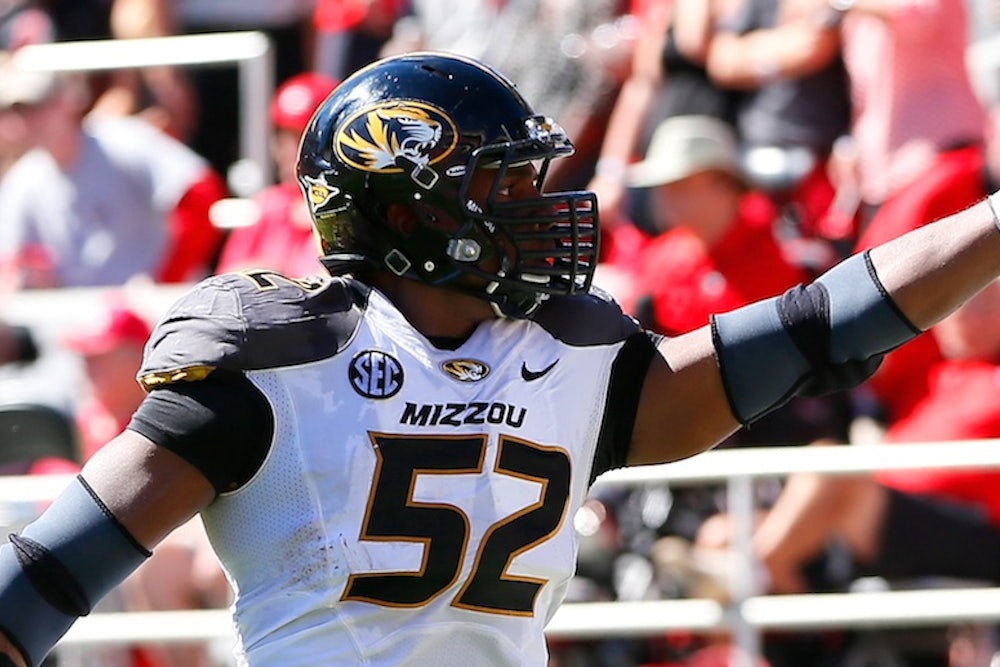If you are a pessimist, you believe that only a few National Football League teams would dare to court the “baggage” involved in drafting Michael Sam, the Missouri defensive end who just came out as a gay man. In a much-circulated Sports Illustrated article that quoted several NFL executives and coaches, a former general manager suggested that only teams with a quality owner, general manager, and head coach would make the leap—and the teams he cited were the Pittsburgh Steelers, Green Bay Packers, San Francisco 49ers, Indianapolis Colts, and Baltimore Ravens. Bleacher Report’s Mike Freeman relayed an NFL scout’s belief that the five best locker rooms would be those of the Seattle Seahawks, New York Giants, New England Patriots, and the Colts and Packers. It is no coincidence that these eight apparently most-welcoming franchises are also more or less the eight most consistently competitive teams.
If you are an optimist, however, you believe that the 32 NFL franchises will be making their decision on Sam the same way they would any other player: analyzing his merits (his college play, his “measurables” at the upcoming combine, what their research says about his character) and then deciding how good a “system fit” he is for their rosters and defensive schemes. “I think that sports, at its best and purest, acts as a meritocracy,” NFL historian Michael MacCambridge emailed me Sunday night. “And what we’re seeing is simply another chapter in the realization that if someone can help you win, it doesn’t matter if that person is black or white... and ultimately, it won’t matter if the person is straight or gay.”
In fact, trends in NFL locker rooms are headed in a more tolerant direction. Deadspin’s Drew Magary wrote an important post this month noting that the coaching style of Seattle’s Pete Carroll—“collaborative” rather than dictatorial—is likely to be the future. That Carroll is the way he is, that Seattle’s locker room is full of different types of personalities, and that Seattle just won the Super Bowl are three related facts. And Carroll’s style was honed in the college game, at the University of Southern California. “Much is made about football’s macho culture,” MacCambridge argued, “but you also have to remember that virtually every player in the NFL spent at least three years on a college campus, with the accompanying socialization and exposure to different lifestyles.” He added, “That heterogeneous college experience tends to supply people with lessons about diversity and tolerance, whether they're conscious of it or not.”
Which team is likely to draft Sam? Sports on Earth’s Mike Tanier wrote an invaluable scouting report. Sam is a very specific type of prospect—so specific that it has its own name. He is a tweener: a skilled pass rusher who, at his best, could work either at defensive end in a 4-3 scheme (with four down linemen and three linebackers) or at outside linebacker in a 3-4 scheme (three linemen, four linebackers), but is not an ideal fit for either. As a linebacker, Sam would frequently be required to drop back into coverage, a skill he would need to be taught. And the problem with making him a pass-rushing defensive end in the NFL is that Sam is only 6’1”, and, his success in the Southeastern Conference aside, the prototype for that position in the pros is taller.
But not always. The Peyton Manning–era Colts were built on small defenses who could execute former head coach Tony Dungy’s conservative Tampa 2. The star pass-rushers at defensive end in that scheme were Dwight Freeney and Robert Mathis—respectively seven-time and six–time Pro Bowlers who are respectively 6’1” and 6’2”. (They converted to outside linebacker two years ago under a new head coach.)
On Monday morning, I spoke to Bill Polian, an ESPN analyst who was the general manager of those Colts teams. “There was a guy named Freeney that played for me and did a heckuva job,” he said. “We did not have a prejudice against short players, so long as everything else was exceptional. We had figured out that in our defensive system—Tony Dungy’s—they could play and play well. We were able to coach them up and accommodate them and make a living off them both.” Polian acknowledged that lack of height is a “detriment” for outside linebackers in a 3-4. Polian declined to name specific teams for which Sam might be a good fit.
A look at which teams deploy which defenses is helpful. This list of each team’s base defense is a year old, but accounting for coaching changes, teams still likely to run a basic 4-3 next season include the Giants, Carolina Panthers, Chicago Bears, Detroit Lions, Jacksonville Jaguars, Miami Dolphins, Oakland Raiders, and Tampa Bay Buccaneers. (Several of the listed 4-3s use more complex versions of the scheme, like Seattle; several others have made coaching changes likely to flip them to the 3-4, like the Tennessee Titans; others are up in the air, like the Minnesota Vikings.)
The Panthers, the Bears, the Lions, and the Bucs have all had 4-3s for some time, which means their personnel fit it. The Lions’ head coach, Jim Caldwell, coached under Dungy, as did the Bucs’ defensive coordinator Leslie Frazier; the Bears’ Tampa 2 was installed by another Dungy acolyte, Lovie Smith, under whom the Panthers’ head coach Ron Rivera coached. Those, in other words, are the teams I’d circle.
“In the end,” said Polian, “it’s not important where he’s drafted, it’s what he does after he’s drafted that counts.” He added, “After a reasonable amount of time, it goes away, and he just becomes another football player. And that’s the way it should be.”
